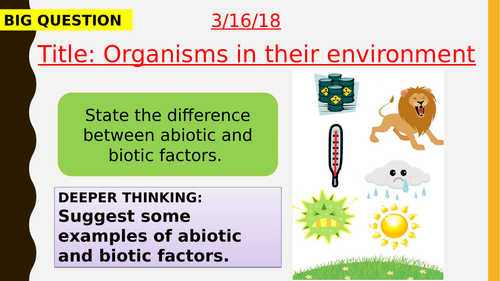

Organisms in their environment lesson created in accordance to the NEW AQA Specification (9-1). Designed for a higher ability class, although content can be adjusted to suit any ability. Includes powerpoint timers, slide animations, embedded video’s and mini review. NB: If you are unable to play embedded videos please view slide notes for link.
AQA spec link: 4.7.1.2 + 4.7.1.3
Relevant chapter: B15 Adaptations, interdependence and competitions. AQA Biology combined edition textbook-Page 208-209
Students are required to know the following;
Students should be able to explain how a change in an abiotic factor would affect a given community given appropriate data or context. Abiotic (non-living) factors which can affect a community are: •• light intensity •• temperature •• moisture levels •• soil pH and mineral content •• wind intensity and direction •• carbon dioxide levels for plants •• oxygen levels for aquatic animals.
Students should be able to explain how a change in a biotic factor might affect a given community given appropriate data or context. Biotic (living) factors which can affect a community are: •• availability of food •• new predators arriving •• new pathogens •• one species outcompeting another so the numbers are no longer sufficient to breed.
Get this resource as part of a bundle and save up to 35%
A bundle is a package of resources grouped together to teach a particular topic, or a series of lessons, in one place.
Something went wrong, please try again later.
This resource hasn't been reviewed yet
To ensure quality for our reviews, only customers who have purchased this resource can review it
Report this resourceto let us know if it violates our terms and conditions.
Our customer service team will review your report and will be in touch.
